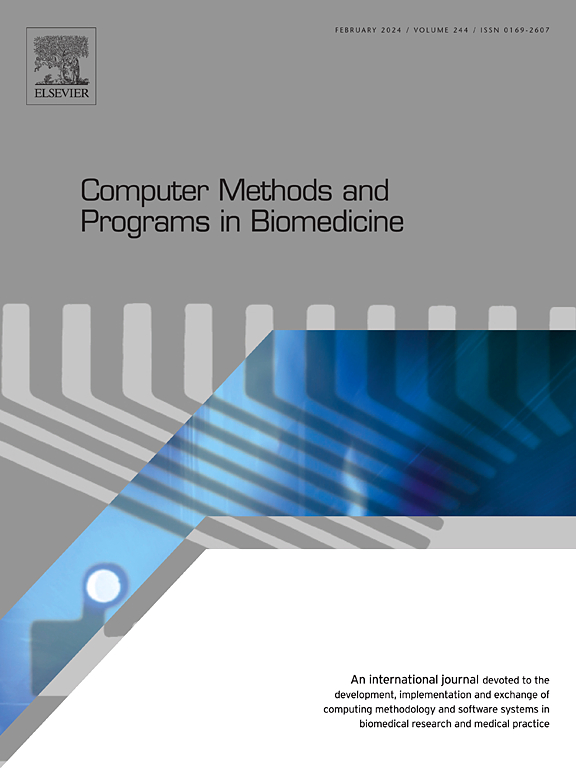Retrieval-based adaptive fusion strategy for medical report generation
IF 4.9
2区 医学
Q1 COMPUTER SCIENCE, INTERDISCIPLINARY APPLICATIONS
引用次数: 0
Abstract
Background and Objective:
Retrieval-based medical report generation methods attempt to improve efficiency by reusing historical reports, but their fixed feature-concatenation strategies often introduce cross-case redundancy. Moreover, most methods are designed for low-resolution X-ray images, and their evaluation metrics rely on textual similarity and overlook the implications of misdescription. To address these, we first constructed a high-resolution CT-report dataset, comprising 9 categories of chest CT scans and corresponding reports from 505 patients. Then, we propose RAFS, a retrieval-based adaptive fusion strategy, to dynamically balance contributions from generation and retrieval modules. Finally, we propose DICE, a dual-perspective integrated clinical evaluation including consensus-based positive scoring and penalties of misdescription.
Methods:
RAFS integrates an attention module to calculate the similarity between the current generated word’s hidden state and the retrieved text, passing the result through a fully connected layer to obtain retrieval probabilities. After, obtained attention weights are feed the Sigmoid function and its result for fusing the generation probabilities and retrieval probabilities.
Results:
RAFS achieves superior performance with BLEU-4, METEOR, ROUGE_L, CIDEr and the average of DICE scores of 45.8, 32.9, 59.1, 79.3 and 64.6 in the CT report generation task, outperforming existing methods. methods.
Conclusion:
RAFS significantly enhances the clinical interpretability of generated reports, with future work dedicated to optimizing the characterization of local pathological lesions.
基于检索的医疗报告生成自适应融合策略
背景与目的:基于检索的医疗报告生成方法试图通过重用历史报告来提高效率,但其固定的特征连接策略通常会引入跨病例冗余。此外,大多数方法都是为低分辨率x射线图像设计的,它们的评估指标依赖于文本相似性,而忽略了错误描述的影响。为了解决这些问题,我们首先构建了一个高分辨率的CT报告数据集,包括9类胸部CT扫描和505名患者的相应报告。然后,我们提出了一种基于检索的自适应融合策略RAFS来动态平衡生成和检索模块的贡献。最后,我们提出DICE,一个双重视角的综合临床评估,包括基于共识的正面评分和错误描述的惩罚。方法:RAFS集成注意力模块,计算当前生成词的隐藏状态与检索文本的相似度,将结果通过全连通层传递,得到检索概率。然后,将得到的注意权值输入到Sigmoid函数中,并将其结果用于生成概率和检索概率的融合。结果:RAFS在CT报告生成任务中,BLEU-4、METEOR、roouge_l、CIDEr得分均优于其他方法,DICE得分平均值分别为45.8、32.9、59.1、79.3、64.6,优于现有方法。方法。结论:RAFS显著提高了生成报告的临床可解释性,未来的工作将致力于优化局部病理病变的表征。
本文章由计算机程序翻译,如有差异,请以英文原文为准。
求助全文
约1分钟内获得全文
求助全文
来源期刊

Computer methods and programs in biomedicine
工程技术-工程:生物医学
CiteScore
12.30
自引率
6.60%
发文量
601
审稿时长
135 days
期刊介绍:
To encourage the development of formal computing methods, and their application in biomedical research and medical practice, by illustration of fundamental principles in biomedical informatics research; to stimulate basic research into application software design; to report the state of research of biomedical information processing projects; to report new computer methodologies applied in biomedical areas; the eventual distribution of demonstrable software to avoid duplication of effort; to provide a forum for discussion and improvement of existing software; to optimize contact between national organizations and regional user groups by promoting an international exchange of information on formal methods, standards and software in biomedicine.
Computer Methods and Programs in Biomedicine covers computing methodology and software systems derived from computing science for implementation in all aspects of biomedical research and medical practice. It is designed to serve: biochemists; biologists; geneticists; immunologists; neuroscientists; pharmacologists; toxicologists; clinicians; epidemiologists; psychiatrists; psychologists; cardiologists; chemists; (radio)physicists; computer scientists; programmers and systems analysts; biomedical, clinical, electrical and other engineers; teachers of medical informatics and users of educational software.
 求助内容:
求助内容: 应助结果提醒方式:
应助结果提醒方式:


